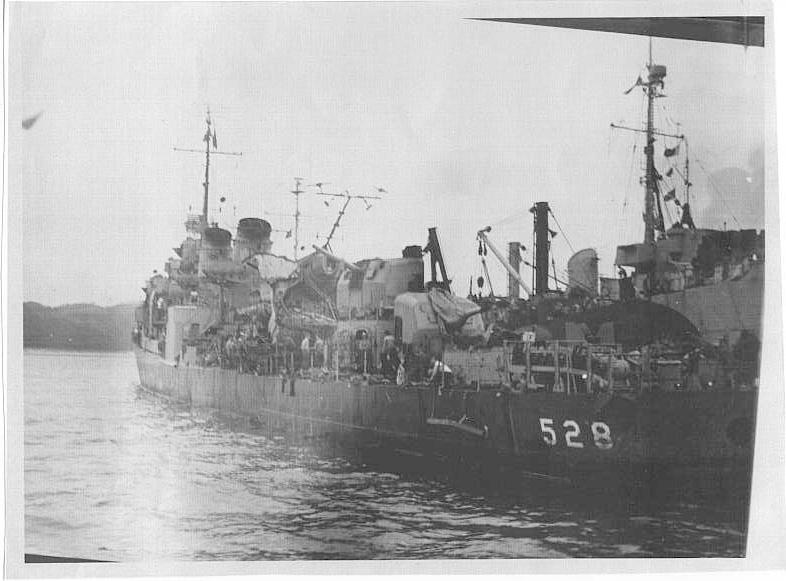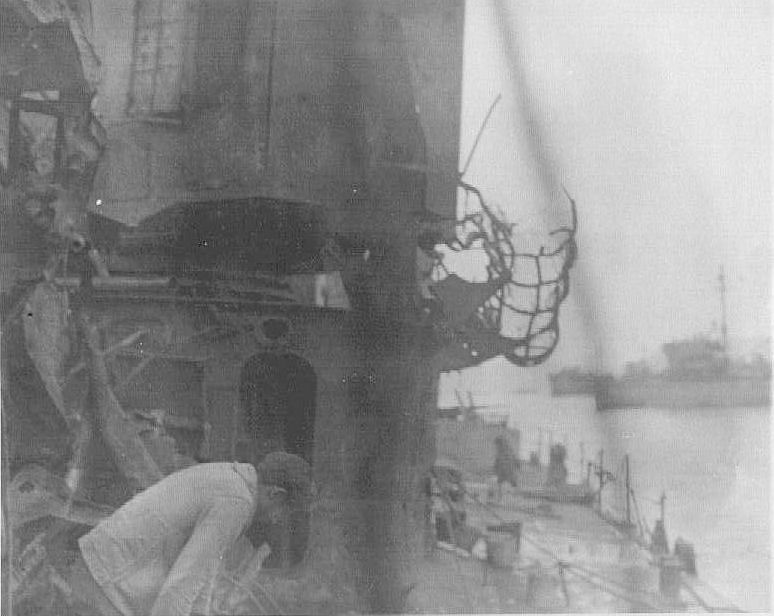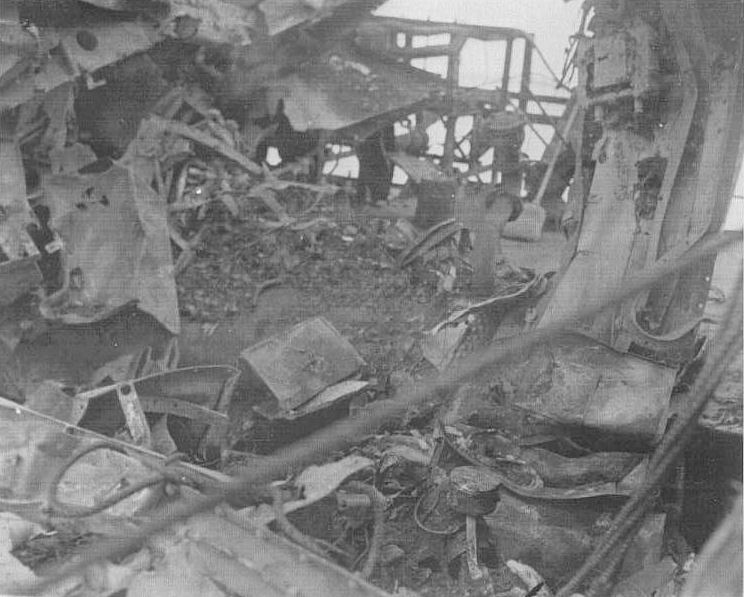By April 1945 the Mullany was back in action off Okinawa. At 17:45 hour on April 6th, all hell broke loose for the Mullany. A squadron of Japanese Kamikaze planes sited the Mullany and started a low level strafing attack. The first plane, a Nakajima Ki-43 fighter (oscar), was hit by anti-aircraft fire from the Mullany. In flames it crashed into the aft deck housing between the number three and four gun mounts. Before damage control parties could remove any wounded from the twisted metal, depth charges began exploding, and the entire ship from the quarter deck to the fantail was in flames. Forward gunners downed two of the other Kamikaze planes, while the fourth flew off damaged.
With the bulkhead of one of the ammo. magazines hot, and an explosion imminent, Capt. Momm, at 18:29 hour, ordered "Abandon ship!". He knew that if the magazine went the ship would be blown out of the water. The USS Gherardi (DMS-30) stood by to take on survivors, and her rescue assistance team played water on the Mullany. In the next hours the USS Purdy (DD-734) came along side and helped extinguished the deck fires, and rescue survivors. When the expected explosion did not occur Capt. Momm took a skeleton crew back on board at 23:00 hours. Upon inspection it was determined that two boilers, and the starboard engine and screw were operational. The reason the magazine had not exploded was a stroke of luck. When the depth charges ignited they ruptured the fuel tanks, and the fresh, and salt water tanks. This flooded the compartment above the magazine and prevented further damage. Capt. Momm wanted to get underway before daylight, and before a new wave of Kamikaze planes. It was a race against time.

The Mullany, steered by hand, limped off in the dark without radar to guide them. As dawn approached the crew saw the harbor at Kerama Retto, and for the first time saw the horror and the full extent of the damage. Dead, charred bodies, and twisted steel were everywhere. In port shipyard workers, and navy personnel, moseyed down to the docks to take a look. None could believe that she could stay afloat, and still get underway, with all the damage. The Mullany had survived, but 21 of her crew had been killed, 9 were missing, and 36 wounded.
(Click on image to enlarge.)
Photo supplied by Lt. Frank H. White 1942-1946

It took three weeks for repair crews to cut away the wreckage and weld steel plates over the jagged holes to make her barely seaworthy. On April 26, 1945 the Mullany put out to sea on one engine, headed across the wide Pacific for Pearl Harbor. A feat she would repeat in the Atlantic eight years later. Thank God for the starboard engine and screw.
(Click on image to enlarge.)
Photo supplied by Lt. Frank H. White 1942-1946
Sailor bending over tentatively identified as John B. Hynes

April 6, 1945
The first heavy attack by Japanese suicide planes was made on US ships at Okinawa.
These attacks continue throughout the Okinawa campaign.
(Click on image to enlarge.)
Photo supplied by Lt. Frank H. White 1942-1946
See Captains Action report.
Sunk by suicide planes in the Okinawa area:
* The destroyers USS Bush (DD-529)
* USS Colhoun (DD-801)
* USS Emmons (DMS-22) high-speed minesweeper
* LST 447
Damaged by accidental US Naval gunfire:
* The battleship USS North Carolina (BB-55),
* The light cruiser USS Pasadena (Cl-65)
* The submarine chaser PCS-1390
* The attack transport USS Barnett (APA-5)
* The attack cargo ship USS Leo (AKA-60) and * LST 241
* LST 1000
Damaged by collision:
* USS Daniel T. Griffin (APD-38) high-speed transport
Damaged by suicide planes:
* USS San Jacinto (CVL-30) light carrier
Destroyers:
* USS Taussig (DD-746)
* USS Morris (DD-417)
* USS Bennett (DD-473)
* USS Hutchins (DD-476)
* USS Leutze (DD-481)
* USS Mullany (DD-528)
* USS Harrison (DD-573)
* USS Newcomb (DD-586)
* USS Howorth (DD-592)
* USS Haynesworth (DD-700)
* USS Hyman (DD-731)
Destroyer escorts
* USS Witter (DE-636)
* USS Fieberling (DE-640)
High-speed minesweepers
* USS Rodman (DMS-21)
* USS Harding (DMS-28)
Minesweepers
* USS Facility (AM-133)
* USS Ransom (AM-283)
* USS Devastor (AM-318)
Motor minesweepers
* YMS 311
* YMS 321
* The Japanese destroyer *Amatsukaze was sunk by Army aircraft
and coast defense vessels No.s 2 and 134 off of China
Japanese minesweeper * No. 22 was sunk by the submarine
USS Besugo (SS-321) in the Netherlands East Indies
After the war it was learned that the pilot of the plane, (a Nakajima KI-43 fighter), was Takeichi Minoshima. The son of a Japanese farmer. He was found charred and mangled on the starboard side, wearing a complete parachute rigging, and was not elaborately dressed similar to other suicide pilots. See the Captains Action Report.



